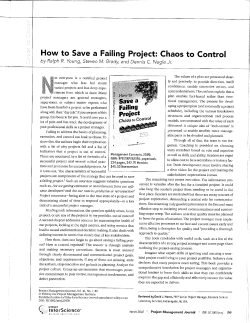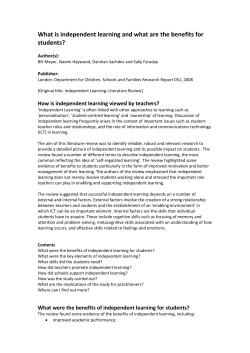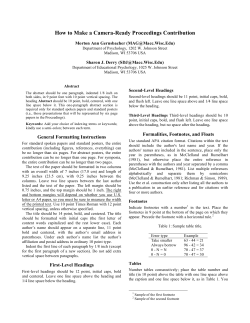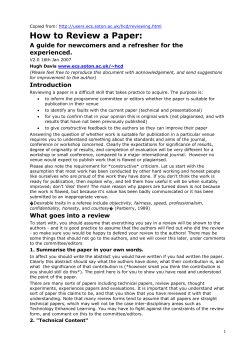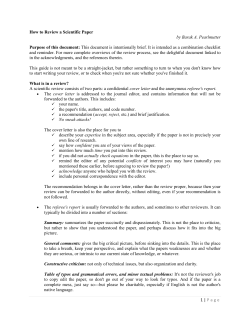
Instructions for authors formatted as a sample manuscript
Instructions for authors formatted as a sample manuscript Petr Schauer and Ludûk Frank Institute of Scientific Instruments AS CR, Královopolská 147, CZ-61264 Brno, Czech Republic 1. Introduction All papers must be written in English and have the same format as the title page. Four pages are reserved for the keynote lectures and invited introductory lectures in symposia. Two pages are available for the contributed papers, both oral ones and posters. The deadline for reception of all papers is February 15, 2000. Papers received after this date may be rejected for this reason. Reception of papers will be acknowledged promptly. The paper should be a condensed version of the final presentation including all significant findings. The completed Paper Data Form on page 23 must be enclosed with each paper. The proceedings will be reproduced as high quality books, preferably from electronic files. Nevertheless, it is obligatory to provide us with two camera-ready originals. Additionally, three copies of each paper must be submitted along with the original. Make sure the copies are of good quality since they -not the original- will be used for review and for assigning the paper to a symposium. Please do not submit colour prints. It is not necessary to provide original micrograph prints for the copies. Insert cardboard sheet(s) in the envelope to prevent bending. Do not send papers by fax. A faxed paper will not be acknowledged or accepted as a "reservation" for an original paper received after the deadline. All papers will be reviewed by symposia chairpersons. Corresponding authors will be notified of acceptance by April 15, 2000. The presenting author will be responsible for presenting the paper at the congress. If unforeseen circumstances prevent his/her attendance, the EUREM secretariat has to be notified as soon as possible and arrangements have to be made for another author or colleague to present the paper. Send papers (two originals and three good copies) along with the completed Paper Data Form to: EUREM 2000, Královopolská 147, CZ - 612 64 Brno, Czech Republic. All information regarding the congress and its programme can be obtained from our Web site http://www.eurem2000.isibrno.cz or by e-mail at eurem2000@isibrno.cz. Overhead and 35-mm slide projectors will be supplied for all oral presentations. Any other required audio/visual equipment (video, data projector, etc.) must be indicated on the Paper Data Form or its availability cannot be guaranteed. Audio/visual equipment may be requested for poster presentations but cannot be guaranteed without previous notification. Please complete the Paper Data Form carefully (page 23). 252 mm Summary: This section contains instructions for authors of papers. Intentionally, this section is written and formatted as a sample manuscript. All submitted papers must look like these four pages as regards the page layout, fonts, headings, subheadings, figure captions, references, etc. The page content has to fit to within the frame indicated which nevertheless should not appear on your originals. Please note that each paper should begin with a brief summary for bibliographical purposes. The summary should be indented 1.27 cm both sides. 2. Paper layout and typing You may type on plain white paper (letter, A4, or any other standard size). The area of typing must not exceed the 25.2 cm height and 17.0 cm width. Leave a margin of 2.5 cm at the page head to place the running heading and final page numbers. Use a laser printer or ink-jet printer or an electric 170 mm 13 typewriter with a carbon ribbon. Please do not use a cloth ribbon, and do not use a matrix dot printer. The recommended font is Times New Roman or Times according to the following sizes: (a) For the title: 16 pts. (b) For the main text (including headings): 12 pts. (c) For affiliations, footnotes, references, figures and tables: 10 pts. The paper heading layout has to be made as shown above. If the title is too long to fit in one line, break at the ends of words rather than hyphenating. Leave approximately 2 cm between the title and the names and addresses of the authors. Type names in 12 pts and addresses in 10 pts indented 1.27 cm from the left-hand margin of the typing area. Leave one line space between the names and addresses. Section and subsection headings should be numbered consecutively in Arabic numerals. The heading should be of the bold type and subheading of the bold italic type. Always start the heading and subheading flush left. Do not include references to the literature, illustrations or tables in headings and subheadings. Keep one blank line above the section heading or subheading. The use of headings and subheadings is optional. The title page should be a text only page. An indentation of 1.27 cm for the first line is recommended. Type the main text on the full typing width. Use the single spacing unless subscripts and superscripts require the 1.5 spacing. The second page (and additional pages for keynote and introductory lectures) may contain the text, tables and figures. Tables (refer to: Table 1, Table 2, …) should be typed as part of the text. Table headings should be placed above the table and centred on the page width. Figures can be provided as original drawings or photographic prints. Greyscale photographs must be glossy prints. Scanned images are allowed only if the paper is also submitted as an electronic file containing these images. Care must be taken to insert the figures in correct alignment with the text. Figure captions should be made as shown below. No part of a figure should go beyond the typing area. The references should be indicated [1,2] and listed at the end of the text. The citation convention is as shown below. When receiving a paper, we assume that the corresponding authors grant us the copyright to use the manuscripts for the book and CD-ROM in question. 3. Posters The papers will be assigned by the symposia chairpersons to either an oral or poster presentation, unless a poster preference is specified on the Paper Data Form, in which case that preference will be honoured. The corresponding authors will be notified of this assignment after the programme has been structured. Each poster will be allocated a 859 mm high by 748 mm wide display area. The board will be covered by a cloth and will allow for use of pins. Audiovisual equipment may be requested for poster presentations. Stereo projection will not be available. NOTE: To guarantee equipment availability, authors must indicate their audiovisual requirements on Paper Data Form (see page 23). 4. Electronic submission and document formats Authors are strongly encouraged to make every effort to submit an electronic file of the document with embedded images. These electronic submissions are an essential step for CD-ROM development and will improve also the quality of printing. The target file format for all papers is Adobe’s Portable Document Format (PDF), and all papers will be distributed on a CD-ROM in PDF together with PDF viewers for Windows and Macintosh. It is possible to translate from many document formats into PDF. In all cases, the highest flexibility in converting formats exists if you provide us with multiple document formats of your paper. For example, if you produce your files in Word, you could submit Word, RTF, and PostScript versions of the file. 14 Electronic files can be submitted in the following formats, listed in the order of preference. (1) PDF files: If you can create a PDF file by yourself, you are encouraged to do so. This minimises translation errors. (2) Rich Text Format: You can produce RTF files from many popular word processing formats, such as Microsoft Word, Word Perfect, AmiPro, and others. (3) Word Processor Files: Only Microsoft Word and Word Perfect files can be accepted. (4) PostScript: These submissions must be formatted to the A4 paper size. Authors must make sure that the submitted PostScript file prints correctly to a PostScript printer. For best results, authors should avoid the use of custom half tones and bitmap pattern fills. Use standard half tones and grey fills instead. QuarkXPress users should not use the "Smooth Graphics" option, as this will result in an inefficient postscript. Windows users who use True Type fonts should be sure to use Type 3 fonts, and select the "Use Printer Fonts for all TrueType fonts" option. These can be set through the "advanced options" dialog box of your PostScript printer control panel. (5) ASCII: If you are unable to submit your paper in any of the above formats, your paper will be scanned and stored as an image. In this case, an ASCII file of your text should be submitted to assure that your submission could be included in keyword searches. 4.1. Images, disc space and author assistance Authors will be permitted to publish up to 1 MB of data, which may be distributed between the paper and images in any fashion desired. Authors are free to choose the image size, resolution, image format, and compression method. The only constraint is that the total submission must fit in 1 MB. Authors are not penalised for submitting multiple formats. That is, if you submit Word and PostScript versions of your paper, the 1 MB ceiling applies to each paper, not to both combined. Assistance will be provided by the EUREM2000 author help. Send e-mail to eurem2000-author.info@isibrno.cz. The subject of your message must indicate what information is asked. The requested information will be e-mailed to the address from which the request was made. Information available through the EUREM2000 Web site will be displayed at the http: //www.eurem2000.isibrno.cz/author.html. College Vinafiská Pavilion A Hotel VoronûÏ Pavilion B Pavilion E VoronûÏ 2 Hotel Holiday Inn Figure 1: The scenery pictures the main buildings of EUREM 12. Hotels Holiday Inn, VoronûÏ and VoronûÏ 2 and College Vinafiská will accommodate the participants, in the pavilion E the majority of the congress events will take place (the symposia and tutorials on the second floor, poster exhibition on the first floor and instrument exhibition and open labs on the ground floor). The opening ceremony will be organised in pavilion B, the welcome party in pavilion A. 15 4.2. File delivery Electronic submissions may be sent to us through several channels. In all cases, you should collect all of the files in your submission into a single archive, with pkzip, rar, arj or tar. You may optionally compress tar archives with GNU zip (gzip) or compress. The name of your file must begin with the symposium number (i.e. the 1st choice you will fill in on the Paper Data Form), continued with your last name, and the extension of the file will correspond with the archive format you submit in. For example, if you select the B6 symposium, your last name is Schauer, and you choose to pkzip your submission, you would submit your file as B6Schauer.zip. Your archive should include the file "contact.txt," which contains your name, paper indication, and any contact information you are willing to provide, such as the e-mail address and phone number. It should also contain "paper.txt," which is an ASCII version of your paper and will be used if your document cannot be converted into PDF. Electronic files can be submitted in the following channels, listed in the order of preference. (1) Anonymous FTP: You may submit via anonymous FTP to the ftp.eurem2000.isibrno.cz. Be sure to give your e-mail address as your password so that we may contact you if we have any trouble. Submissions must be placed in the /incoming directory, and the filename must contain your paper indication (for example B6Schauer.zip). Be sure to switch into binary mode before transferring the files. Many FTP programs (for example Windows Commander or CuteFTP) automatically switch into binary mode and give your e-mail address as your password. Thus, the FTP submission is as easy as the file move or copy in a file manager. (2) E-mail: You can submit your paper via e-mail, but you must be careful to send only 7bit, encoded data. You may encode your binary data with MIME, uuencode, or BinHex. Many e-mail programs automatically MIME encode, or BinHex binary attachments, so you may want to use such a mailer. E-mail submissions should be sent to eurem2000-submissions@isibrno.cz, with your paper indication (for example B6Schauer.zip) as the subject header. (3) Postal service: Papers may be submitted (together with camera-ready originals and copies) on a 3.5” DOS or Macintosh floppy disk. 5. Summary of the most important information The paper (two camera ready originals and three good copies) has to reach us not later than February 15, 2000. The originals will be used for production of both printed and CD-ROM proceedings in case the electronic file is not available or its processing fails. It is advantageous both for authors and organisers to submit the paper also as an electronic file, sent to us also on the same date. Papers will be reviewed by the symposia chairpersons and only a few of the best papers in a symposium will be selected for the oral presentation. References [1] [2] [3] 16 J. Smith, P. Novák, Ultramicroscopy 55 (1994) 458. A. Brown: Introduction to electron optics. Springer, Berlin 1989, p. 303. P. Jones, in: Proc. 14th ICEM, Cancun 1998, Vol. 1, 124.
© Copyright 2025

